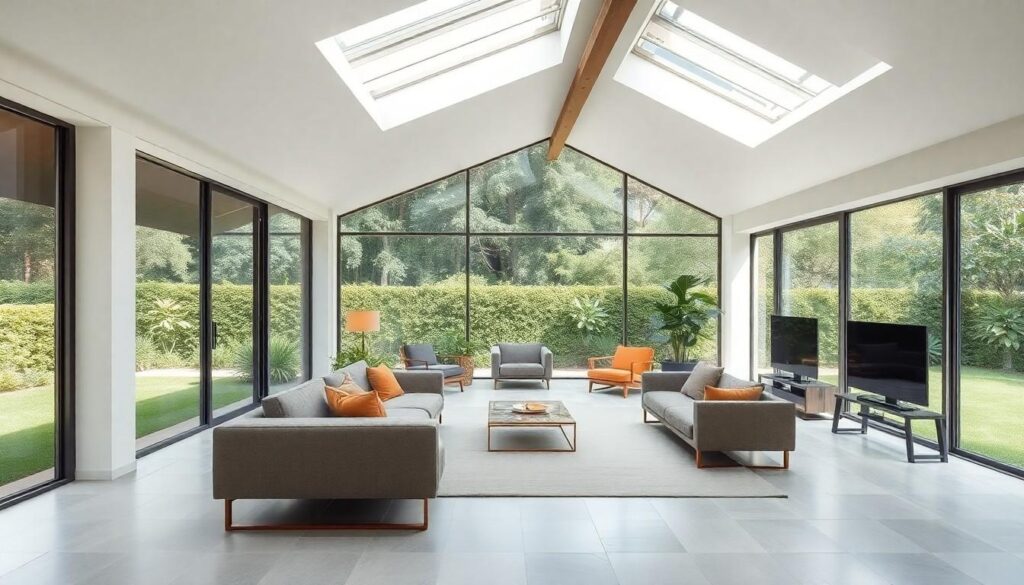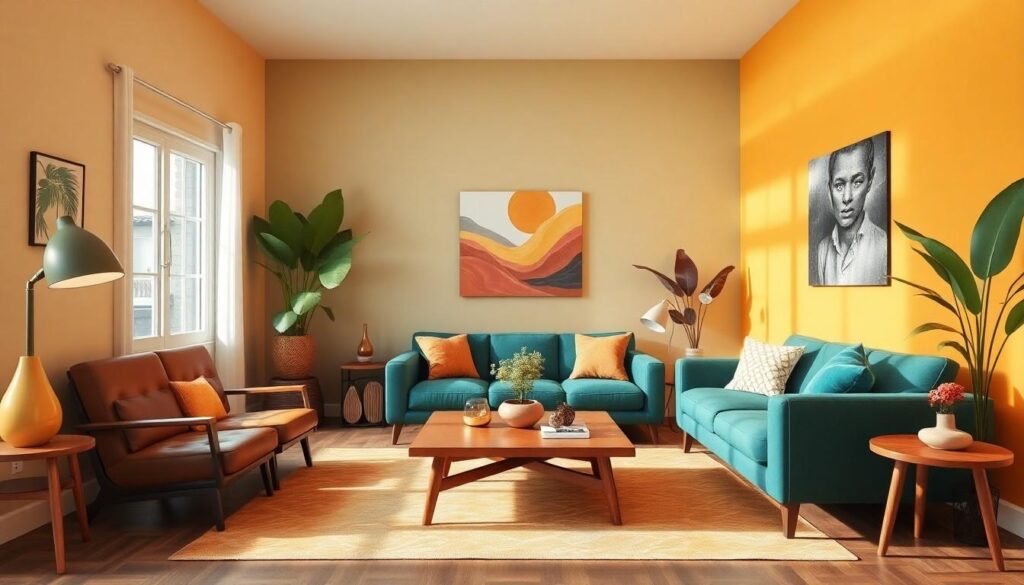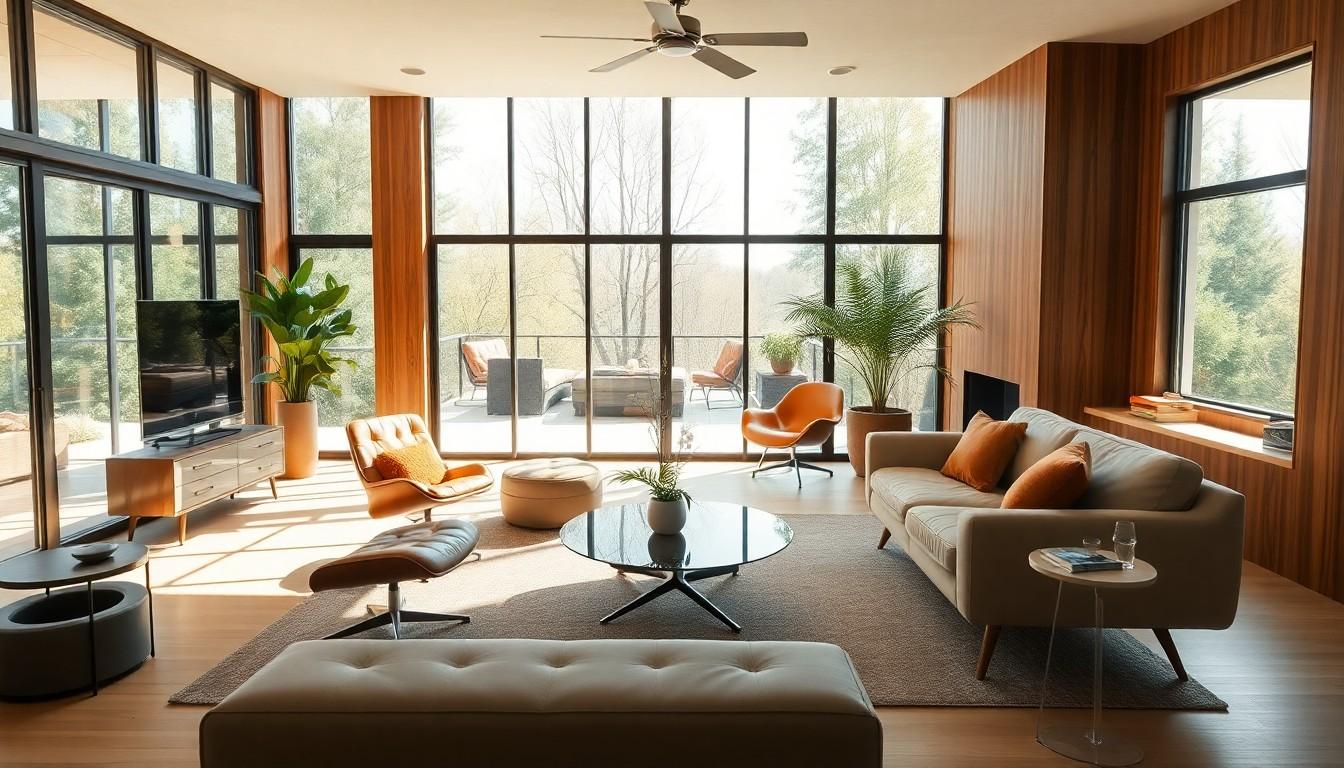Mid-century modern design continues to captivate homeowners with its timeless appeal that seamlessly blends functionality with aesthetic beauty. This design philosophy emerged in the mid-20th century as a rebellion against ornate traditions, embracing instead a more organic way of living that prioritizes clean lines and purposeful spaces.
What makes this style so enduring is its perfect balance of simplicity and innovation.
Unlike the elaborate decorative styles of earlier periods, mid-century modern celebrates the beauty in simplicity without sacrificing style.
You’ll find open floor plans where every room has a clear purpose, furniture strategically placed away from walls, and a commitment to the idea that form should always follow function.
The Essence of Mid-Century Modern Interior Design
Mid-century modern interior design captivates with its perfect balance of beauty and practicality. This distinctive style creates spaces that feel both timeless and fresh, appealing to homeowners seeking clean lines and purposeful aesthetics.
Historical Context and Design Philosophy
Mid-century modern emerged in post-WWII America, responding to changing lifestyles and new housing needs. German designers who fled to America during this period brought Bauhaus principles with them, influencing what would become a distinctly American style.
The movement flourished from roughly the 1940s through the 1960s, transforming how Americans thought about their living spaces.
Post-War Origins and Bauhaus Influence
The devastation of World War II created a unique opportunity for design innovation.
These German-influenced designs prioritized futuristic aesthetics that felt optimistic and forward-looking during a time of national rebuilding.
The Bauhaus school’s philosophy, combining craftsmanship with industrial production, found fertile ground in America where it evolved to include more organic forms and warmer materials like wood.
As families sought practical, affordable housing solutions, designers responded with furniture and architecture that emphasized clean functionality.
Form Meets Function: The Core Philosophy
At its heart, mid-century modern design follows the principle that “form follows function.” Unlike earlier decorative styles, mid-century pieces serve a clear purpose first, with their beauty emerging naturally from their utility. You’ll notice this philosophy in the clean lines, minimal ornamentation, and practical features of signature pieces.
This commitment to purposeful design makes mid-century modern spaces feel ordered and intentional, never cluttered or overwhelming.
Each element, from cantilevered chairs to integrated storage solutions, looks beautiful precisely because it works so well.
Open floor plans create breathable, versatile spaces that accommodate family life.
Spatial Design Principles

Mid-century modern spatial design creates harmonious environments where form and function unite perfectly. These spaces feel both timeless and practical, with an emphasis on openness that supports modern living.
Open Floor Plans and Strategic Furniture Placement
Mid-century modern spaces break traditional room divisions in favor of connected, flowing areas.
Rooms that feel spacious yet intimate, with carefully curated pieces that each serve a purpose without creating visual clutter.
The result?
This “floating” arrangement maintains clear pathways while defining functional zones within larger spaces.
You’ll notice furniture intentionally placed away from walls, creating conversation islands and flexible gathering spots throughout a room.
Bringing the Outdoors In
Large windows and dramatic glass walls blur the boundaries between indoor and outdoor living, a signature element of mid-century design.
This indoor-outdoor flow not only expands the perceived size of rooms but creates spaces that feel fresh and alive with changing seasons and natural light.
Picture floor-to-ceiling windows framing garden views or sliding glass doors that open to courtyards.
These transparent barriers flood interiors with natural light, reducing dependence on artificial lighting while creating a constant connection to nature.
Dynamic Architectural Elements
Sloped ceilings create instant drama in mid-century spaces, drawing your eye upward and giving modest rooms a sense of grandeur.
Clerestory windows, those narrow bands of glass positioned high on walls, typically accompany these sloping ceilings, introducing pools of natural light that shift throughout the day. These architectural elements transform ordinary rooms into light-filled, dynamic spaces with distinctive character.
These angled planes often rise from a lower wall to a dramatically higher point, creating visual movement throughout the space.
Furniture: The Backbone of Mid-Century Modern Design

Furniture forms the backbone of mid-century modern interior design, with pieces exemplifying clean lines, gentle curves, and organic shapes. Straightforward and unornamented, unlike frillier pieces with decorative detailing from previous periods, mid-century furniture perfectly balances form and function.
Characteristic Materials and Forms
Teak dominates mid-century furniture design, prized for its rich color and exceptional durability.
These juxtapositions create character while celebrating each material’s unique properties in furnishings that feel both sculptural and practical.
Rosewood and oak also make frequent appearances in tables, desks, and storage pieces. What makes this style so distinctive is its fearless material combinations – warm woods paired with cool metals, transparent glass contrasting with textured vinyl.
Iconic Pieces That Defined an Era
The Eames lounge chair stands as perhaps the most recognizable mid-century piece, with its molded plywood shell cradling supple leather cushions in perfect harmony.
Other standouts include the sculptural Noguchi coffee table with its glass top balanced on an asymmetrical wooden base, and the innovative Togo sofa with its slouchy, modular design. These pieces weren’t just furniture – they were revolutionary statements that challenged conventional thinking about how we live and relax in our homes.
Contemporary Adaptations
Today’s mid-century inspired pieces keep the style feeling fresh rather than dated.
Contemporary designers honor the original principles while introducing sustainable materials and modular functionality that works for today’s lifestyles. The beauty of these adaptations is how they serve as room anchors – investment pieces that instantly elevate your space with their distinctive character.
Statement sofas and lounge chairs sporting low-profile silhouettes dominate modern interpretations, often dressed in rich velvet or textured corduroy upholstery.
Color Palettes and Material Applications

Mid-century modern aesthetics embrace a distinct approach to color and materials, creating spaces that feel both timeless and expressive. These elements work together to form the visual language that makes this style instantly recognizable.
Nature-Inspired Color Spectrum
The mid-century palette draws directly from nature’s bounty, featuring earthy greens, vibrant fall oranges, sunny yellows, and rich muddy browns.
What’s fascinating about mid-century color application is how these natural tones were used in revolutionary ways – bold accent walls, striking furniture pieces, and unexpected color blocking techniques that made individual elements pop dramatically against neutral backgrounds. These colors don’t just decorate spaces – they energize them.
Sea-inspired blue-greens like aquamarine and teal add refreshing depth, while deep clay reds bring warmth and drama.
Innovative Material Combinations
Mid-century designers were material pioneers, constantly exploring new combinations that created visual tension and interest.
These combinations strike a delicate balance between neutral foundations (often in warm woods) and strategic color pops in furnishings, art, and accessories, giving mid-century interiors their distinctive character.
This juxtaposition – the organic against the manufactured, the natural against the synthetic – celebrates each material’s unique properties while creating dynamic visual conversations.
Traditional materials like warm woods, supple leather, and clear glass found themselves paired with newer innovations like molded plastics, vinyl, lucite, and fiberglass.
Wall Treatments and Architectural Elements
Wall treatments offer excellent opportunities to incorporate mid-century modern characteristics into interior spaces. These elements define the character of a room while complementing furniture and accessories.
Bold Accent Walls
Mid-century modern spaces come alive with bold accent walls that deliver visual punch. Authentic period colors like burnt orange, mustard yellow, and teal blue transform ordinary rooms into vibrant statements.
These strategic color moments draw the eye and anchor furniture groupings, adding depth and dimension to open-concept layouts.
Paint just one wall to create an instant focal point without overwhelming the space.
Textured Finishes for Depth and Warmth
Tactile wall treatments add richness to mid-century spaces while maintaining clean lines. Grasscloth wallpaper brings natural, organic texture that softens angular furniture pieces.
For DIY options, techniques like sponge or rag rolling add understated texture that complements wood tones. These finishes create warmth without competing with statement furniture or art.
Stucco and Venetian plaster create subtle dimension that catches light throughout the day.
Classic Wood Paneling
Wood paneling remains the quintessential mid-century wall treatment, bringing warmth and architectural interest to any room. Oak and teak panels installed vertically create the clean, streamlined appearance that defines the era.
The natural grain patterns add organic visual texture while maintaining simplicity. Today’s versions can be stained in honey tones or even whitewashed for a contemporary update that maintains mid-century character.
Geometric Wallpapers and Patterns
Geometric wallpapers capture mid-century modern’s playful side with bold patterns and vibrant colors. Diamond motifs, starburst patterns, and abstract shapes energize walls while creating authentic period charm.
A geometric accent wall becomes instant art, no additional decor needed.
These dynamic patterns often echo shapes found in lighting fixtures and furniture silhouettes, creating cohesive design connections throughout the space.
Curated Gallery Walls
Gallery displays offer a personalized approach to mid-century wall design. Grid-style arrangements with consistent spacing and identical frames create the clean, ordered look the style demands.
The arrangement itself becomes as important as the artwork it contains.
Black and white photography collections feel especially period-appropriate and sophisticated. For authenticity, incorporate vintage abstracts, atomic-inspired art, or geometric prints in slim frames.
Accent Decor and Accessories
Mid-century modern accessories add personality and character to spaces through carefully selected statement pieces rather than numerous small items. These thoughtfully placed accents become conversation starters while maintaining the style’s uncluttered aesthetic.
Organic Ceramics
Mid-century ceramics bring a handcrafted feel that beautifully contrasts with the clean lines of furniture.
The intentionally imperfect, almost brutalist quality of these ceramics creates an interesting juxtaposition against more geometric furniture elements, adding warmth and tactile appeal to minimalist spaces.
These pieces often feature organic shapes with earthy, speckled glazes and textural elements like volcanic surfaces or ribbed patterns.
Statement Lighting Fixtures
Lighting in mid-century spaces isn’t just functional; it’s sculptural art. Iconic designs like Sputnik chandeliers with their starburst forms, sleek cone pendants, and tripod floor lamps with angled legs create distinctive silhouettes that command attention.
These dramatic fixtures serve as architectural focal points, casting interesting shadows and light patterns while expressing the era’s fascination with space-age aesthetics and innovative forms.
Distinctive Textiles
Mid-century textiles embrace bold geometric patterns, abstract florals, and color blocking that energize living spaces.
The patterns often feature clean lines and organic shapes that complement, rather than compete with, the furniture’s distinctive silhouettes.
These textiles stay true to the style by avoiding fussy details like fringes, beading, or embellishments.
Look for heathered weaves and tweed fabrics that add subtle texture without overwhelming the eye.
Sophisticated Metal Accents
Warm brass hardware transforms everyday elements like drawer pulls and doorknobs into jewelry for your furniture. The subtle glow of these metallic touches catches light beautifully, creating visual points of interest throughout a room.
Wall-mounted metal art pieces featuring abstract or geometric designs add sculptural dimension to otherwise simple walls, creating dynamic shadow play and reflecting the era’s appreciation for artistic craftsmanship in everyday objects.
The Enduring Appeal of Mid-Century Modern Design
Mid-century modern design isn’t just a style but a philosophy that continues to resonate in today’s homes. Its genius lies in creating spaces that feel both nostalgic and relevant decades after its inception.
You’ll find the true magic of mid-century design in how it solves everyday problems through beauty. Whether it’s through a perfectly proportioned Eames chair or an open floor plan that brings nature indoors this aesthetic proves great design never goes out of style.
As you incorporate these elements into your own space remember that mid-century modern is about intentional choices rather than perfection. It’s about creating a home that works for your life while bringing joy through thoughtful design that stands the test of time.

